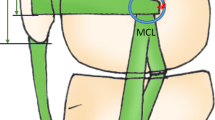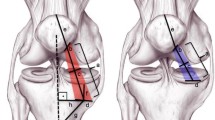Abstract
Purpose
The aim of this study was to investigate the shape and the attachments of the medial patellofemoral ligament (MPFL) in cadaver specimens to determine an anatomical basis for the best MPFL reconstruction.
Methods
Twenty fresh-frozen knees were used. Dissection protocol implied performing dissections from within the knee joint. We investigated the shape and the attachments between the MPFL and the quadriceps tendon, the patellar and femur insertions, and all the other relationships with the medial soft tissues of the knee.
Results
The distal fibers of MPFL were interdigitated with the deep layer of the medial retinaculum. All isolated ligament had a sail-like shape with the patellar side bigger than the femoral side. The femoral insertion, distinct both from medial epicondyle and adductor tubercle, was located at 9.5 mm (range 4–22) distal and anterior respect to adductor tubercle and proximal and posterior to epicondyle. The medial third of the thickness of patella was involved in the insertion. The proximal third of the patella is always involved in the MPFL attachment; in 45 % of the cases, it was extended to the medial third and in one case, an extension at the distal third was found. Additionally in 35 % (7 cases), it extended to the quadriceps tendon and it were inconstantly attached at the vastus medialis obliques (VMO) tendon and at the vastus intermedius (VI) tendon in an aponeurotic structure.
Conclusions
The MPFL is a distinct structure that goes from patella to femur with a sail-like shape; its patellar insertion, that mostly occur via an aponeurosis tissue with VMO and VI, is at the proximal third of the patella but it may extend in some cases to the medial third patella or to the quadriceps tendon, or very rarely to the distal third of the patella. In the femoral side, the MPFL is inserted in its own site, in most cases distinct both from epicondyle and adductor tubercle, located on average at a 9.5 mm distance distally and anteriorly in respect to the adductor tubercle. Its lower margin was difficult to define. Given the importance of this structure, it must be reconstructed as anatomically as possible in its insertion and in its shape. Many attempts have been made to make functional reconstructions with less than excellent results.








Similar content being viewed by others
References
Amis AA, Firer P, Mountney J, Senavongse W, Thomas NP (2003) Anatomy and biomechanics of the medial patellofemoral ligament. Knee 10:215–220
Andrikoula S, Tokis A, Vasiliadis HS, Georgoulis A (2006) The extensor mechanism of the knee joint: an anatomical study. Knee Surg Sports Traumatol Arthrosc 14(3):214–220
Aragão JA, Reis FP, Vasconcelos DPD, Feitosa VLC, Nunes MAP (2008) Metric measurements and attachment levels of the medial patellofemoral ligament: an anatomical study in cadavers. Clinics 63(3):541–544
Baldwin JL (2009) The anatomy of the medial patellofemoral ligament. Am J Sports Med 37:2355–2361
Conlan T, Garth WP, Lemons JE (1993) Evaluation of the medial soft-tissue restraints of the extensor mechanism of the knee. J Bone Joint Surg Am 75:682–693
Desio SM, Burks RT, Bachus KN (1998) Soft tissue restraints to lateral patellar translation in the human knee. Am J Sports Med 26:59–65
Feller MJ, Feagin JA, Garrett WE (1993) The medial patellofemoral ligament revisited: an anatomical study. Knee Surg Sports Traumatol Arthrosc 1(3–4):184–186
Felus J, Kowalczyk B (2012) Age-related differences in medial patellofemoral ligament injury patterns in traumatic patellar dislocation case series of 50 surgically treated children and adolescents. Am J Sports Med 40:2357–2364
Hautamaa PV, Fithian DC, Kaufman KR, Daniel DM, Pohlmeyer AM (1998) Medial soft tissue restraints in lateral patellar instability and repair. Clin Orthop Relat Res 349:174–182
Kim TK, Chung BJ, Kang YG, Chang CB, Seong SC (2009) Clinical implications of anthropometric patellar dimensions for TKA in Asians. Clin Orthop Relat Res 467(4):1007–1014
LaPrade RF, Engebretsen AH, Ly TV, Johansen S, Wentorf FA, Engebretsen L (2007) The anatomy of the medial part of the knee. J Bone Joint Surg 89(9):2000–2010
Mochizuki T, Nimura A, Tateishi T, Yamaguchi K, Muneta T, Akita K (2013) Anatomic study of the attachment of the medial patellofemoral ligament and its characteristic relationships to the vastus intermedius. Knee Surg Sports Traumatol Arthrosc 21(2):305–310
Nomura E, Horiuchi Y, Kihara M (2000) Medial patellofemoral ligament restraint in lateral patellar translation and reconstruction. Knee 7(2):121–127
Nomura E, Inoue M, Osada N (2005) Anatomical analysis of the medial patellofemoral ligament of the knee, especially the femoral attachment. Knee Surg Sports Traumatol Arthrosc 7:510–515
Panagiotopoulos E, Strzelczyk P, Herrmann M, Scuderi G (2006) Cadaveric study on static medial patellar stabilizers: the dynamizing role of the vastus medialis obliquus on medial patellofemoral ligament. Knee Surg Sports Traumatol Arthrosc 14(1):7–12
Philippot R, Boyer B, Testa R, Farizon F, Moyen B (2012) The role of the medial ligamentous structures on patellar tracking during knee flexion. Knee Surg Sports Traumatol Arthrosc 2:331–336
Philippot R, Chouteau J, Wegrzyn J, Testa R, Fessy MH, Moyen B (2009) Medial patellofemoral ligament anatomy: implications for its surgical reconstruction. Knee Surg Sports Traumatol Arthrosc 17(5):475–479
Placella G, Tei M, Sebastiani E, Speziali A, Antinolfi P, Delcogliano M, Georgoulis A, Cerulli G (2014) Anatomy of the Medial Patello-Femoral Ligament: a systematic review of the last 20 years literature. Musculoskelet Surg. doi:10.1007/s12306-014-0335-y
Putney SA, Smith CS, Neal KM (2012) The location of medial patellofemoral ligament injury in adolescents and children. J Pediatr Orthop 32(3):241–244
Reider B, Marshall JL, Koslin B, Ring B, Girgis FG (1981) The anterior aspect of the knee joint. J Bone Joint Surg 63(3):351–356
Schindler OS, Scott WN (2011) Basic kinematics and biomechanics of the patello-femoral joint. Part 1: the native patella. Acta Orthop Belg 77(4):421–431
Sillanpää PJ, Mäenpää HM (2012) First-time patellar dislocation: surgery or conservative treatment? Sports Med Arthrosc 20(3):128–135
Smirk C, Morris H (2003) The anatomy and reconstruction of the medial patellofemoral ligament. Knee 10(3):221–227
Steensen RN, Dopirak RM, Maurus PB (2005) A simple technique for reconstruction of the medial patellofemoral ligament using a quadriceps tendon graft. Arthroscopy 21(3):365–370
Steensen RN, Dopirak RM, McDonald WG (2004) The anatomy and isometry of the medial patellofemoral ligament Implications for reconstruction. Am J Sports Med 32(6):1509–1513
Tuxøe J, Teir M, Winge S, Nielsen P (2002) The medial patellofemoral ligament: a dissection study. Knee Surg Sports Traumatol Arthrosc 10(3):138–140
Warren LF, Marshall JL (1979) The supporting structures and layers on the medial side of the knee. J Bone Joint Surg Am 61(1):56–62
Zaffagnini S, Colle F, Lopomo N, Sharma B, Bignozzi S, Dejour D, Marcacci M (2013) The influence of medial patellofemoral ligament on patellofemoral joint kinematics and patellar stability. Knee Surg Sports Traumatol Arthrosc 21(9):2164–2171
Author information
Authors and Affiliations
Corresponding author
Rights and permissions
About this article
Cite this article
Placella, G., Tei, M.M., Sebastiani, E. et al. Shape and size of the medial patellofemoral ligament for the best surgical reconstruction: a human cadaveric study. Knee Surg Sports Traumatol Arthrosc 22, 2327–2333 (2014). https://doi.org/10.1007/s00167-014-3207-y
Received:
Accepted:
Published:
Issue Date:
DOI: https://doi.org/10.1007/s00167-014-3207-y




